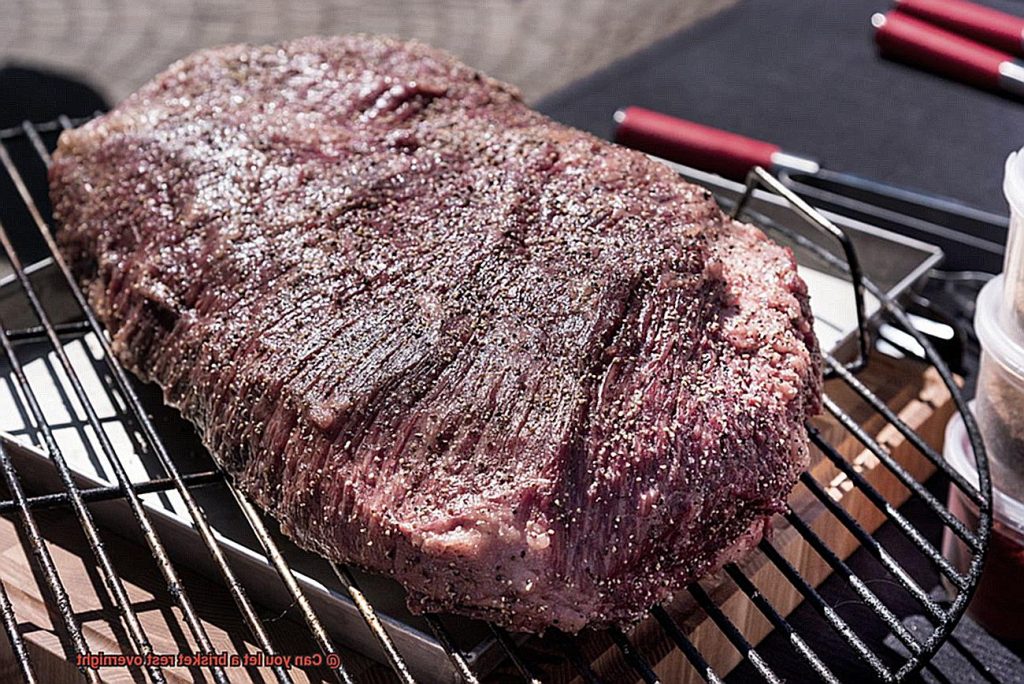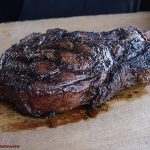Are you a meat lover or a barbeque enthusiast? If so, then you’ve probably heard of the mouth-watering delicacy known as brisket. This large cut of beef is cooked slowly over low heat until it’s tender, juicy, and flavorful. But what happens after it’s cooked? Can you let a brisket rest overnight?
The answer is simple – yes, you can let a brisket rest overnight. However, the more important question is whether it’s a good idea or not. Brisket is a delicate meat that requires time and effort to cook to perfection. After hours of slow-cooking over low heat, letting it rest can be the key to achieving that perfect texture and flavor.
In this blog post, we’ll explore why letting a brisket rest overnight is essential for its taste and texture. We’ll delve into the science behind brisket cooking and explain how resting allows the juices to redistribute and the meat to become even more tender. Additionally, we’ll discuss the best ways to store your brisket overnight and how to reheat it the next day.
If you’re an aspiring brisket cook or just a curious foodie, this post is for you. By the end of this article, you’ll have all the knowledge you need to become an expert in the art of making perfect briskets. So sit back, relax, and get ready to learn why letting your brisket rest overnight could make all the difference in your cooking skills.
Contents
What is Brisket?
Brisket is a cut of beef that has become a popular staple in barbecue cultures worldwide. This flavorful meat comes from the breast or lower chest of a cow and is known for its tough and stringy texture, which requires proper cooking techniques to transform it into a mouthwatering delicacy.
There are two main types of brisket: the flat and the point. The flat is leaner and flatter, while the point has more fat and marbling, giving it a richer flavor. When purchasing brisket, it’s important to choose a cut with enough fat to keep the meat moist during cooking.
One of the most crucial stages in cooking a brisket is the resting period. This allows the juices to redistribute within the meat, resulting in a more tender and flavorful brisket. If you need to let your brisket rest overnight, make sure to wrap it correctly with foil or butcher paper to prevent bacteria growth and keep it moist. Store it in the refrigerator during the resting period and reheat it properly before serving.
Brisket can be cooked in various ways, such as smoking, braising, and roasting. It’s often seasoned with rubs or marinades before cooking to add flavor and tenderize the meat. Many barbecue enthusiasts believe that low and slow cooking is vital to achieving a good brisket. Depending on the size of the cut, this can take anywhere from 8 to 16 hours.
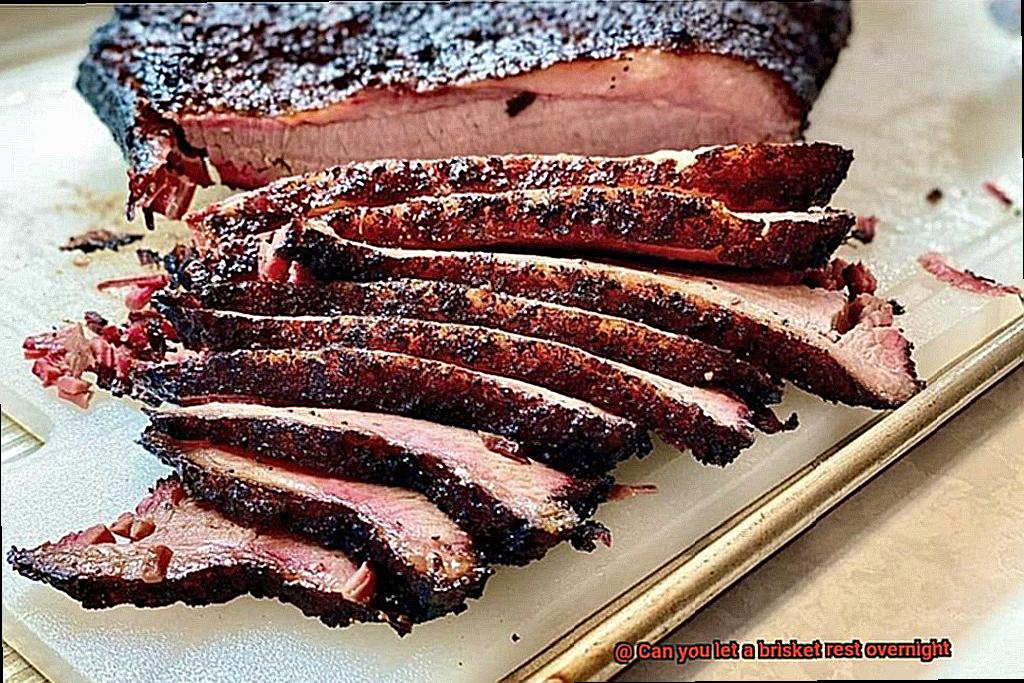
In Texas, where barbecue culture reigns supreme, brisket is an essential part of any cookout. From traditional salt-and-pepper rubs to creative marinades, Texans know how to make a mouthwatering brisket that will leave you craving more.
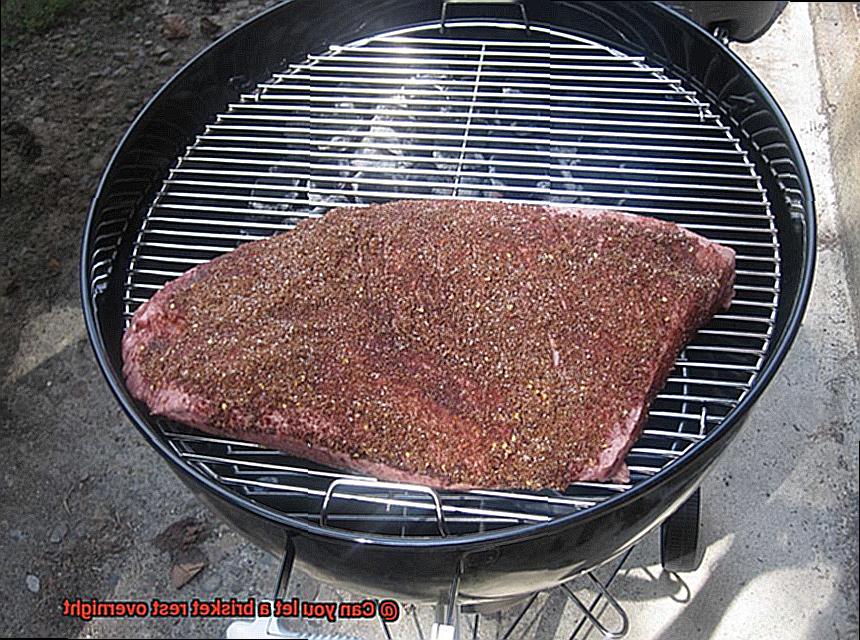
What is Resting and Why It Is Important?
When it comes to cooking meat, it’s the little things that make a big difference. One of those little things is resting. But what exactly is resting, and why is it so important?
Resting is the process of allowing cooked meat to sit for a certain period before carving or serving. It might seem like an insignificant step, but it can mean the difference between a mouthwatering delicacy and a dry, tough piece of meat. Take brisket, for example. This cut of beef is notoriously tough and stringy; however, when cooked properly, it can be transformed into a tender and flavorful dish.
During cooking, the heat causes the juices in brisket (and other meats) to move towards the center of the meat. If you immediately slice the brisket, those precious juices will escape, leaving you with a dry and less flavorful result. That’s where resting comes in – it allows the meat to cool down and for the juices to redistribute evenly throughout the meat. This process not only helps retain moisture but also enhances the flavor and tenderness of the meat.
The recommended resting time for a brisket is usually 20-30 minutes, but many experts suggest letting it rest for up to 2 hours or even overnight. But resting isn’t just applicable to brisket – all types of meat benefit from resting. Whether you’re grilling, roasting, or smoking your meat, giving it time to rest allows for a more consistent and flavorful end result.
Professional chefs consider resting as one of the most important steps in cooking meat and have made it a standard part of their cooking process. They know that resting provides a more consistent texture and flavor throughout the entire dish.
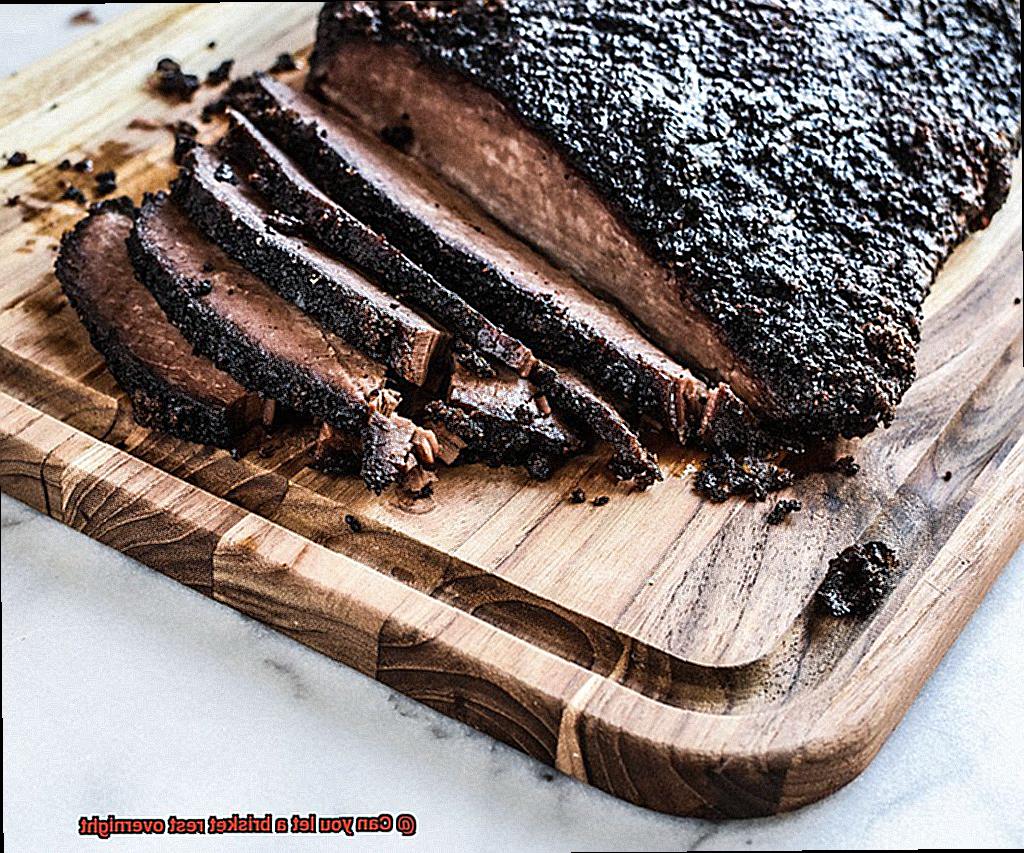
Can You Let a Brisket Rest Overnight?
Well, look no further than the resting process. Resting your brisket after cooking is essential to achieving that juicy and tender final product. But what if you want to let it rest overnight? Is it possible? The answer is yes, but it requires proper care and attention.
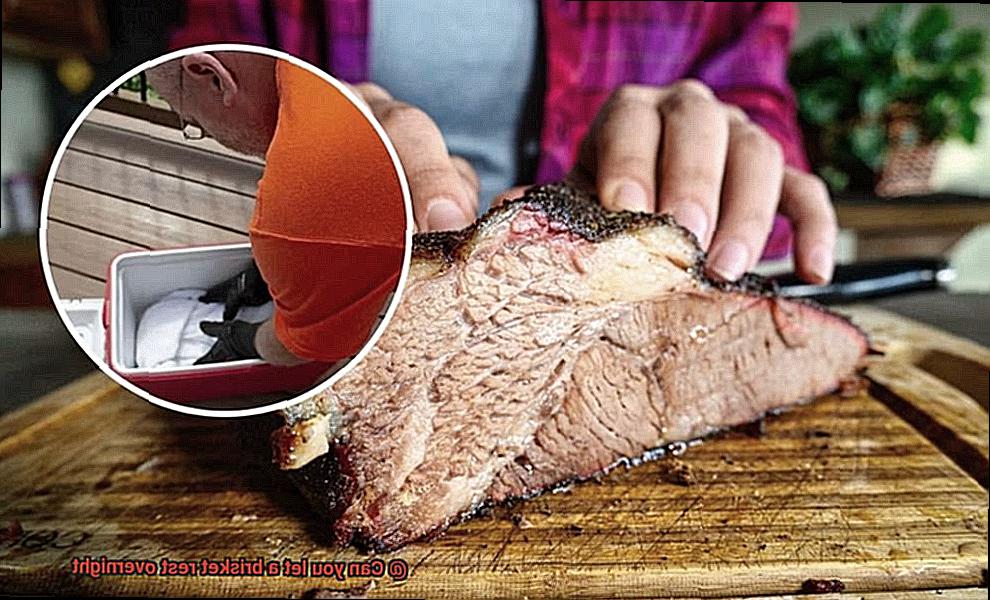
To understand why resting meat is necessary, we need to look at what happens during the cooking process. When meat is cooked, the heat causes the juices inside to move towards the surface. Resting allows the juices to redistribute through the meat, making it more tender and juicy. For brisket, this can take up to an hour or two.
Now, if you’re considering letting your brisket rest overnight, food safety should be your top priority. The USDA recommends that cooked food should not be left at room temperature for more than two hours. Beyond this time frame, bacteria can grow and cause foodborne illnesses. Therefore, it’s crucial to refrigerate your brisket as soon as possible after cooking.
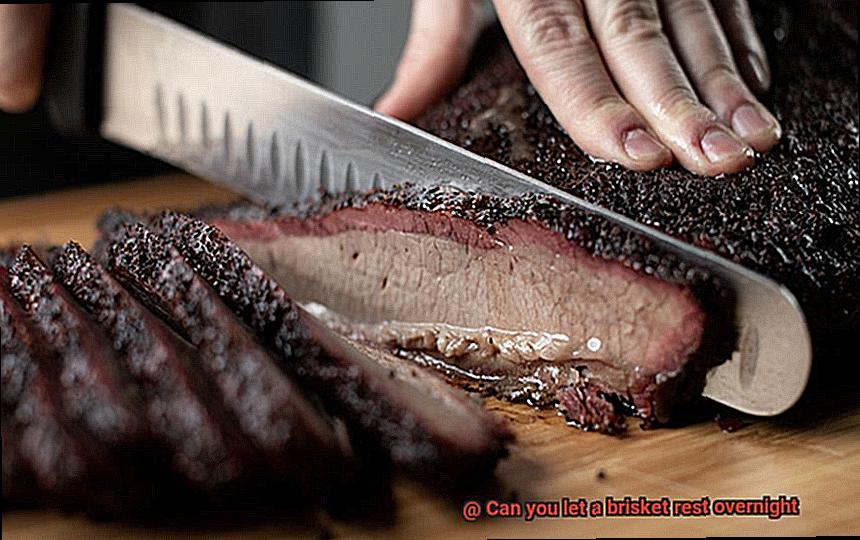
The next step is proper refrigeration. Cooling down your brisket before refrigeration is crucial to prevent increasing the internal temperature of the fridge and spoiling other foods. After cooling down, wrap the brisket tightly with foil or plastic wrap and place it in an airtight container. This ensures that no air gets in, which can cause freezer burn and affect the quality of the meat.
When it’s time to reheat your brisket, remove it from the fridge and let it sit at room temperature for about an hour before reheating. This ensures that the meat comes to room temperature and prevents overcooking during reheating. You can reheat the brisket in an oven, smoker, or on a grill using low heat until it reaches an internal temperature of 165°F.
Wrapping the Brisket Properly
Then, it’s time to talk about the art of wrapping. Properly wrapping your brisket is a crucial step in achieving that melt-in-your-mouth texture and unforgettable flavor. So let’s dive into the details and learn how to wrap like a pro.
First things first, choose your wrapping material wisely. Foil is a popular option because it’s easy to handle and provides a tight seal, but don’t be afraid to experiment with other options like butcher paper or even banana leaves. The key is to choose a material that will keep all those delicious juices right where they belong – inside the brisket.
Once you’ve chosen your wrap of choice, it’s time to get wrapping. Start by removing your brisket from the heat source and letting it cool for a few minutes. This will allow the juices to settle and prevent any spills when you wrap it up. Place your brisket in the center of your foil or paper, making sure that the shiny side of the foil (if using) is facing inward.
Now comes the important part – creating a tight seal. Fold the edges of the foil or paper up and over the brisket, making sure to tuck in any loose corners or edges. The goal here is to prevent any juice from escaping during the cooking process. If you have a particularly large brisket, don’t hesitate to use multiple sheets of foil or paper, just make sure each layer is tightly sealed.
With your brisket now wrapped up like a present, it’s time to let it rest overnight. This step is crucial for allowing those juices to redistribute throughout the meat, resulting in maximum flavor and tenderness. Place your wrapped brisket in a cooler or refrigerator and resist the temptation to peek until morning.
Once that glorious day arrives and it’s time to serve your masterpiece, simply unwrap your brisket and slice against the grain. It’s that easy. By taking the time to properly wrap your brisket, you’ll be rewarded with a tender and juicy final product that will have your guests coming back for seconds (and maybe even thirds).
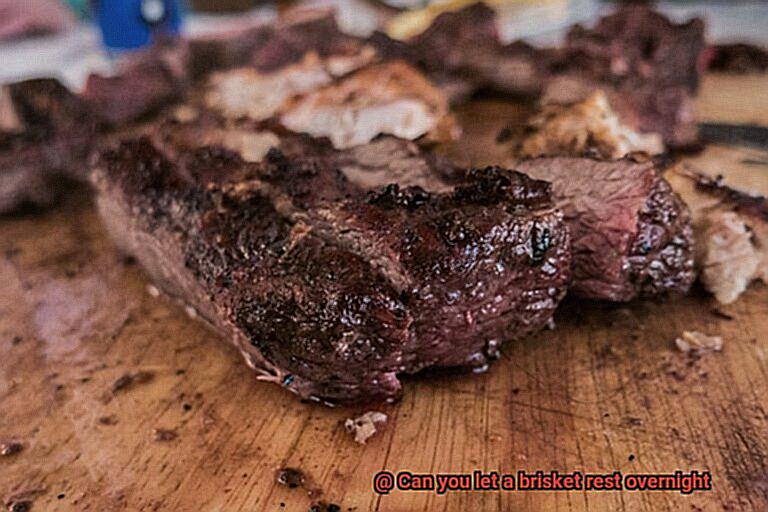
Storing the Brisket in the Refrigerator
You’ve finally mastered the art of making the perfect brisket. Now, it’s time to store it in the fridge and preserve all your hard work. But wait, before you wrap it up and call it a day, there are a few things you need to know to ensure your brisket stays fresh and delicious.
Firstly, make sure your brisket has cooled down completely before placing it in the refrigerator. This is crucial as it prevents any bacteria from multiplying in the warm environment. Once cooled, wrap your brisket tightly in plastic wrap or aluminum foil to ensure no air gets in. The last thing you want is for your precious brisket to dry out before it’s had a chance to be devoured.
If you want to go the extra mile, place your wrapped brisket in a large ziplock bag for added protection. This step is optional, but it definitely won’t hurt.
It’s important to note that a brisket can be stored in the refrigerator for up to four days only. If you plan on storing it for longer than that, it’s best to freeze it. When freezing your brisket, make sure to wrap it tightly and label it with the date so you know when it was frozen.
When reheating your brisket, remove it from the fridge and let it come to room temperature for about an hour before reheating. This will ensure that your brisket heats evenly throughout and is as juicy as the day you made it.
To sum up, here are some key storage techniques for keeping your brisket fresh:
- Cool completely before refrigerating
- Wrap tightly in plastic wrap or aluminum foil
- Optional: place in a large ziplock bag for added protection
- Refrigerate for up to four days only
- Freeze if storing for longer than four days
- Label with date before freezing
- Let come to room temperature before reheating
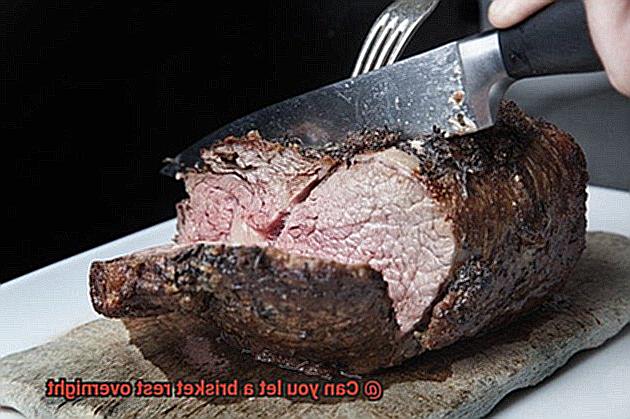
Reheating the Brisket Safely
Now, the next challenge is how to reheat it safely without compromising its texture and taste. Reheating brisket can be challenging, but with the right technique, you can achieve the perfect reheated brisket.
The first step to reheating brisket safely is to ensure that it has been stored properly. Wrap it tightly in plastic or foil, label it with a date before freezing, and let it come to room temperature before reheating.
Step 1: Choose the Right Method
The best way to reheat brisket is by using a slow and low method. You can use a smoker or oven set at a low temperature. This method ensures that the brisket is heated evenly and thoroughly without drying out. However, if you’re short on time, you can also reheat it in a microwave.
Step 2: Bring It to Room Temperature
Before reheating, remove the brisket from the refrigerator and let it come to room temperature. This process allows for more even heating and prevents the brisket from becoming tough. Slicing the brisket before reheating also helps it heat up more quickly and evenly.
Step 3: Use a Meat Thermometer
When reheating, use a meat thermometer to ensure that the internal temperature of the brisket reaches at least 165°F (74°C). This is the minimum safe temperature for cooked meat. Reheating multiple times increases the risk of bacterial growth; therefore, avoid reheating the same brisket multiple times.
Step 4: Be Patient
Reheating brisket safely requires patience and attention to detail. By using a slow and low method and ensuring that the internal temperature reaches at least 165°F (74°C), you can enjoy delicious leftover brisket without compromising your health.
Quick Tips:
- Use a Microwave: You can reheat your brisket quickly using a microwave, but be sure to use a microwave-safe dish. Cover the brisket with a damp paper towel to prevent it from drying out and reheat it on medium power for shorter intervals, checking the temperature with a meat thermometer after each interval.
- Store Leftovers Properly: Proper storage and handling are critical in preventing foodborne illnesses. Store leftovers in airtight containers or plastic bags, label them with dates, and refrigerate or freeze them promptly.
OXvAHBS4JPs” >
Conclusion
In conclusion, allowing a brisket to rest overnight is not only feasible but also imperative for achieving that ideal texture and flavor. Resting permits the juices to redistribute, resulting in meat that is even more tender and flavorful. It is essential to follow proper storage techniques when letting a brisket rest overnight. The brisket should be cooled entirely before wrapping it tightly with foil or plastic wrap and placing it in an airtight container in the refrigerator. If you plan on storing it for more than four days, freezing is recommended.
Reheating brisket can be challenging, but using a slow and low method guarantees that the meat is heated evenly without drying out. Bringing it to room temperature before reheating helps prevent the brisket from becoming tough. It’s also crucial to use a meat thermometer to ensure that the internal temperature reaches at least 165°F (74°C) for safe reheating.
Overall, mastering the art of cooking and resting a brisket requires dedication and effort. However, with these tips and techniques, anyone can become an expert in creating mouthwatering delicacies that will leave your guests craving more.

